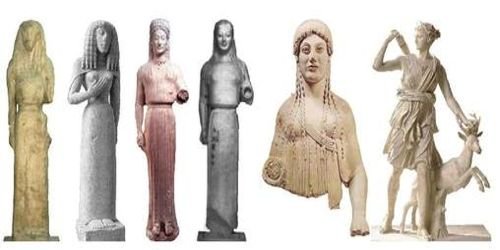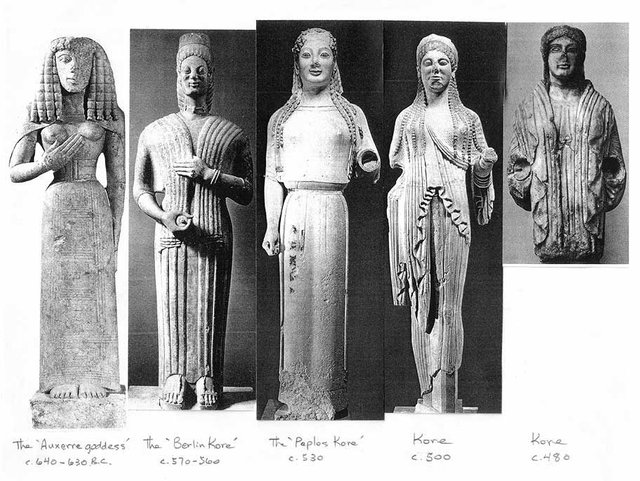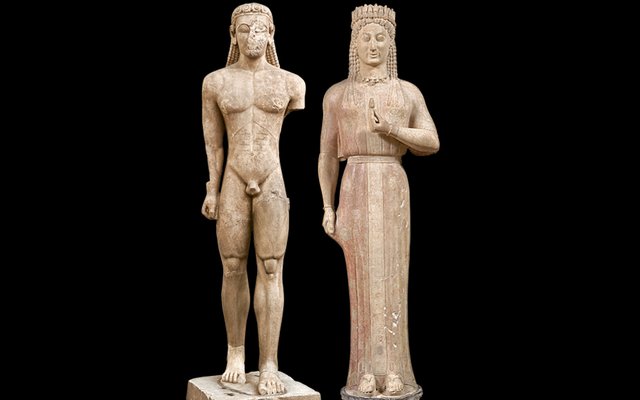All Hail These Korai
The term korai refers to life-sized marble statues of young Greek women and translates to "maidens." Kore, the singular form of korai, means "maiden" or "girl" in Greek; Kore is also another name for the Greek goddess Persephone.
However, not all the korai represented unmarried women or Persephone.
Korai have been found both in sanctuaries to goddesses and in cemeteries. While few of the statues contain inscriptions that explain their purposes, sculptors, or dedicators, the locations of their findings hint that they served as dedications from wealthy women to specific goddesses, and as funeral markers for the tombs of wealthy women.
Wealthy women are often connected to the korai because life-size statues in Greek sanctuaries were some of the most expensive dedication gifts.
Sanctuary Korai
The oldest existing kore was dedicated to the goddess Artemis at her sanctuary on Delos. A Naxian woman, Nicandre, dedicated the statue; the inscription on the side of the statue's dress details Nicandre's name, family, and her status as a married woman.
This statue dates to around 650 B.C.E.; it is the earliest dedication by a Greek woman as well as the earliest surviving Greek monumental stone sculpture. The statue's pose resembles Egyptian sculpture.
The most korai uncovered come from the Acropolis. These korai, numbering between 54 and 75, were dedicated to the goddess Athena. They date to about 570 to 480 B.C.E.; the earliest statues wore a simple Dorian peplos (or woolen garment), while later statues wore elaborate Ionic chiton.
The korai were damaged and buried on the slope of a hill following the Persian invasion of the Acropolis in 480 B.C.E. In the 1880s, they were rediscovered.
Funeral Korai
One of the most well-known funeral kore was unearthed in the Attic countryside in 1972. This kore represents Phrasicleia, a young woman who lived around 530 B.C.E. and whose epigram records she died before marrying.
Her ornate costume, jewelry, and polos (a conical headdress often associated with goddesses) reflect her family wealth.
The Meaning of the Korai
Scholars have long struggled with the meaning of the korai; a lack of inscriptions and identifying attributes has made it difficult to comprehend the statues. The layered fabrics, jewelry, and coiffure of the korai may have reflected the appearance of ancient aristocratic women and their familial and class wealth.
Some scholars see the korai as representations of specific goddesses, while others see them as nymphs, mythical daughters, mortal maidens, anonymous female votaries, worshippers, or priestesses.
In Portrait of a Priestess: Women and Ritual in Ancient Greece, Joan Breton Connelly employs a diachronic view to explore connections between the archaic korai and subsequent female statues. Inscribed bases of female statues from the Classical and Hellenistic periods divulge the identities of priestesses and sacred-office holders.

Source
Connelly proposes that the korai are not goddesses but female worshippers and cult agents, commemorated for their ritual service to female deities, predecessors of later priestess statues.
Women in the ancient Greek world up through the Imperial period expressed their religious duties, status, wealth, and priestly roles through offerings, inscriptions, and memorials. Some women had the financial resources to set up statues, korai, which have survived throughout the centuries.
The korai may have represented and belonged to a long and rich tradition of women priestesses, sacred servants, and worshippers in Greek religious life.
Reference: Joan Connelly - Portrait of a Priestess: Women and Ritual in Ancient Greece


wow your pictures are original